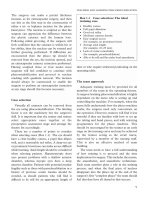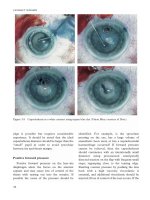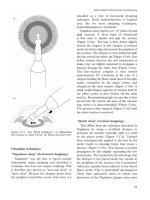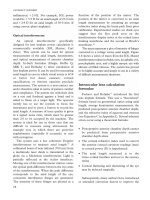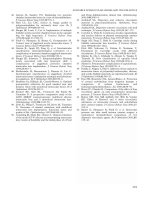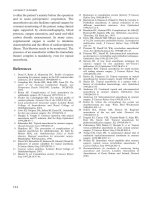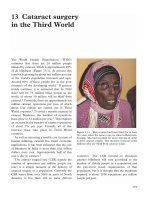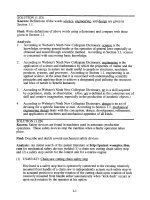Wireless networks - Lecture 13: Fundamentals of cellular networks (Part 3)
Bạn đang xem bản rút gọn của tài liệu. Xem và tải ngay bản đầy đủ của tài liệu tại đây (328.23 KB, 21 trang )
Wireless Networks
Lecture 13
Fundamentals of Cellular Networks (Part III)
Dr. Ghalib A. Shah
1
Outlines
Last lecture review
Interference and system capacity
► Co-channel interference and capacity
► Adjacent channel interference and capacity
Channel Planning for Wireless System
2
Last lecture review
Channel Assignment Strategies
Handoff Strategies
► When to handoff
► 1G, BS based
► 2G or today’s, Mobile-Assisted
Prioritizing Handoff
► Guard channels concept
► Queuing handoff requests
Practical handoff considerations
► Umbrella cell
► Cell dragging
3
Interference and system capacity
Sources of interference
►
►
►
►
Another mobile in the same cell
Call in progress in a neighboring cell
Other BS operating in same frequency
Another non-cellular system leaks energy into cellular
frequency band
Interference on voice channels causes cross-talk
On control channels, interference leads to missed and
blocked calls
A major bottleneck in increasing capacity
Two major types
► Co-channel and adjacent channel interference
4
Co-channel interference and system
capacity
Co-channel cells: cells that use the same set of
frequencies and interference is called co-channel
interference
By increasing SNR, co-channel can not be combated
To reduce it, co-channel cells must be separated by a
min distance
When size of each cell is approximately same and BS
transmit at same power, co-channel interference ratio is
independent of transmission power and is a function of
radius of cell (R) and distance between centers of
nearest co-channel cell (D)
5
By increasing the ratio of D/R,
► separation between co-channel cells relative to coverage
distance of a cell is increased.
► Thus interference is reduced.
The parameter Q (co-channel reuse ratio) is related to
cluster size. Thus for a hexagonal geometry
A small value of Q provides larger capacity since N is cluster size
Large value of Q improves transmission quality due to smaller level
of co-channel interference
A trade-off must be made between these two objectives
6
Let i0 be the number of co-channel interfering
cells, then the signal-to-interference ratio for a
mobile receiver which monitors a forward
channel is
► where S is the desired signal power from desired BS
and Ii is the interference power caused by ith
interfering co-channel cell
7
Average received signal strength at any point decays
as a power law of the distance of separation between
transmitter and receiver
Average received power P r at a distance d from the
transmitting antenna is approx
► Where Po is the power received at a close-in reference point at
a small distance do from the transmitting antenna, n is path loss
exponent ranging between 2 and 4
8
Now consider co-channel cell interference
If Di is the distance of ith interferer from the
mobile, the received power will be proportional
to (Di)-n
When the transmit power of each BS is equal
and the path loss exponent is same throughout
coverage then S/I can be approximated as
9
Considering only the first layer of interfering
cells, which are equidistant D from the desired
BS
Eqn 4 implies to
► It relates S/I to cluster size N, which in turn
determines the overall capacity of the system
10
For US AMPS system, tests indicate that for
sufficient voice quality S/I should be greater or
equal to 18 dB.
By using Eqn 5, in order to meet this
requirement, N should be at least 6.49
assuming n=4.
Thus a minimum cluster size of 7 is required to
meet S/I requirement of 18 dB
It should be noted Eqn 5 is based on
hexagonal cell geometry
11
For 7-cell cluster,
hexagonal cell
geometry layout
Mobile is at the
boundary of the cell
12
The worst case S/I ratio can be approximated using Eqn 4
The above Eqn can be rewritten in terms of co-channel reuse ratio
Q as
For N=7, the value of Q is 4.6
The worst case S/I is approximated as 49.56 (17 dB) using Eqn 7,
where exact solution using Eqn 4 is 17.8 dB.
13
Example
If S/I is required 15 dB for satisfactory forward channel
performance, what is the frequency reuse factor and cluster size
that should be used for maximum capacity if path loss exponent n
=4 and n =3? Assuming 6 co-channel cells in first tier at same
distance from desired BS
► n =4, lets consider 7-cell reuse
• Using Eqn. 1, reuse ratio is 4.583
• Using 5, S/I =1/6 x (4.583)^4 =75.3 =18.66 dB
• Since this is greater than min required, N=7 can be used
► n =3, first consider 7-cell reuse
•
•
•
•
•
•
S/I =1/6 x (4.583)^3 =16.04 =12.05 dB
Since this is less than min required,
Next possible value of N is 12-cell reuse (i =j =2)
Using Eqn. 1, reuse ratio is 6.0
S/I =1/6 x (6)^3 =36 =15.56 dB
Since this is greater than min required S/I, So N=12 is used
14
Channel Planning for Wireless Systems
Generally available spectrum is divided into channels
used throughout a country or continent
► Control channels
•
5% of total devoted for initiating, requesting or paging a call, data
messages
► Voice channels
•
95% dedicated for revenue generating traffic
► Channels may be assigned by wireless carrier in any manner
depending on particular propagation conditions or services it
wishes to offer
► However, control channels are not allowed to be used as voice
channels or vice versa
► Control channels are vital for any successful launch of call, the
frequency reuse strategy or S/I is more conservative than voice
channels
► While voice channels are assigned only 7-cell reuse, control
channels are allocated using 21-cell reuse
15
Key feature of CDMA systems is that cluster size N =1,
frequency reuse planning is not as difficult as for TDMA
or 1G systems
However, most practical CDMA use some sort of
limited frequency reuse due to ill-behaved propagation
conditions
For example interfering channels on same channel can
create interference overload that exceeds the dynamic
range of CDMA power control capabilities, leading to
dropped calls
Most popular approach is to use f1/f2 cell planning,
where nearest neighbor cells use channels that are
different from its closest neighbor
This would require mobiles to make hard handoff
16
In CDMA a single 1.25 MHz channel carries 64
simultaneous voice channels
CDMA system has dynamic time varying coverage
region depending on instantaneous number of users,
known as bre athing ce ll
The wireless engineer has to carefully plan the
coverage and signal levels for best and worst cases of
serving cell as well as neighboring cell from both
coverage and interference view.
Breathing cell can lead to abrupt dropped calls
Hence, the engineer must make difficult decision of
power levels and thresholds
17
Adjacent channel interference
Interference resulting from signals which are
adjacent in frequency
It results from imperfect receiver filters which
allow nearby frequencies to leak into passband
It is more serious if the transmitter is more
close to the user’s receiver listening to desired
channel
This is near-far effect
► A nearby transmitter captures the receiver of
subscriber.
► Or mobile close to BS transmits on adjacent channel
18
to one being used by a weak mobile
Adjacent channel interference can be minimized by
careful filtering and channel assignment
A cell need not be assigned channels adjacent in
frequency
By keeping frequency separation in a given cell
between channels as large as possible, interference
can considerably minimized
By sequentially assigning successive channels to
different cells, channel allocation schemes are able to
separate channels in a cell as many as N
Some assigning strategies also avoid use of adjacent
channels in neighboring cell sites.
19
If reuse factor (1/N) is large i.e. N is small, the
separation may not be sufficient to keep intf within
tolerable limits.
For example if a close-in mobile is 20 times as close to
BS as another mobile and energy has leaked to
passband, S/I at BS for weak mobile is approx
S/I =(20)-n
For n-4, this is -52 dB
If filter of BS receiver has a slope of 20 dB/octave then
intf must be displaced 6 times the passband bandwidth
from the center to achieve 52 dB attenuation
This implies more than 6 channels separation are
needed for an acceptable S/I level
20
Summary
21

